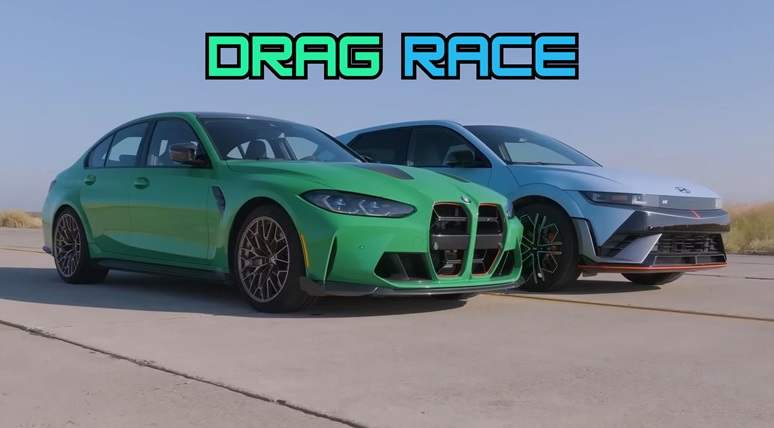In the world of performance cars, drag races between electric vehicles (EVs) and traditional combustion-powered cars have become a thrilling spectacle. The excitement stems from the contrasting technologies at play: the instant torque of an EV versus the proven power and engineering of a combustion engine. But what happens when two seemingly evenly matched competitors go head-to-head? That’s exactly what we see in this drag race between the turbocharged BMW M3 CS and the electric Hyundai Ioniq 5 N. Despite the Hyundai’s impressive electric power, the BMW, with its lighter weight, is the one that ultimately takes the lead—though not by much.

Power vs. Weight: A Classic Showdown
The Hyundai Ioniq 5 N is a powerhouse with 601 horsepower and a torque rating of 533 lb-ft. But here’s the catch: when the “N” button is pressed, the power surges to 641 horsepower, and torque skyrockets to 568 lb-ft. This burst of energy lasts for about 10 seconds—just enough time to gain an edge in a straight-line drag race. The BMW M3 CS, on the other hand, has a turbocharged inline-six engine, generating 543 horsepower and 479 lb-ft of torque.
While the Hyundai has more power on paper, the BMW has a significant advantage: weight. The M3 CS is almost 1,000 pounds lighter than the Ioniq 5 N. This lower weight means the BMW can put its power to the ground more efficiently, and it’s a key factor in its performance during the race. EVs are known for their instant power delivery, but the M3 CS’s lighter weight allows it to stay ahead in the race, though not by much.
The Twist: Adding Handling to the Mix
Most drag races are all about straight-line speed, but this race adds an interesting twist. After a quarter-mile, both cars have to perform a U-turn, introducing an element of handling into the mix. This is where things get interesting because while one car may excel in a straight line, it may not fare as well in the corners.
In a typical drag race, cornering and braking are not considered important factors. However, with this U-turn challenge, a car that excels in straight-line speed might struggle when it comes to handling. The BMW M3 CS, known for its precision and agility, takes full advantage of this element and is able to maintain its lead, despite the Hyundai’s extra burst of power in the initial moments of the race.
The Role of Artificial Sounds and Performance
It’s also worth noting that during the second run of the race, when the drivers were switched, the Hyundai Ioniq 5 N appeared to have its artificial engine noise turned on. This sound, meant to mimic the roar of a combustion engine, also triggers fake gear shifting sounds, which can impact the car’s outright pace slightly. This factor doesn’t necessarily make the Hyundai slower, but it does add an extra layer to the race’s complexity.
Meanwhile, the BMW M3 CS’s performance remains consistent throughout both runs, with no noticeable drop in its speed. The car’s multiple gear ratios and more traditional power delivery give it an edge in maintaining high speeds over longer distances. This is where the BMW’s engineering comes into play, making it not only faster but more predictable in its performance.
Acceleration and Quarter-Mile Times: Not Much Difference
When it comes to acceleration, the two cars are closer than you might think. Edmunds measured the BMW M3 CS’s 0 to 60 mph time at an impressive 3.1 seconds, while the Hyundai Ioniq 5 N managed a 3.3-second sprint. Both of these times are incredibly fast, with the BMW shaving off just one-tenth of a second compared to Hyundai’s official claims.
In the quarter-mile, the BMW M3 CS clocked in at 11 seconds flat, while the Ioniq 5 N took 11.2 seconds. This small difference in time further highlights how evenly matched the two cars are, despite the significant differences in their power sources. The Ioniq 5 N’s electric power allows for quick acceleration off the line, but the BMW’s lighter weight and multiple gears help it maintain a consistent edge.
A Victory for the M3 CS, but a Triumph for the Ioniq 5 N
Ultimately, the BMW M3 CS emerges as the winner in this race, but the margin is so small that it speaks volumes about the Hyundai Ioniq 5 N’s performance. Despite being a less expensive, electric vehicle, the Ioniq 5 N holds its own against one of the most revered sports sedans in the world. This demonstrates just how far EVs have come in terms of performance, and the Ioniq 5 N stands out as a serious contender in the performance car world.
The race also highlights the difference in price between the two cars. The BMW M3 CS comes with a hefty price tag—nearly double that of the Hyundai Ioniq 5 N. Given the performance gap is so narrow, the Hyundai Ioniq 5 N is an impressive option for those looking for a high-performance electric vehicle that won’t break the bank.
This race between the BMW M3 CS and Hyundai Ioniq 5 N is more than just a test of power and speed—it’s a testament to the advancements in electric vehicle technology. While the BMW M3 CS remains the king of this race, the Hyundai Ioniq 5 N proves that electric cars can compete at the highest level of performance. The future of performance cars is undoubtedly exciting, with both combustion and electric vehicles pushing the boundaries of speed, power, and innovation.
Related Post
